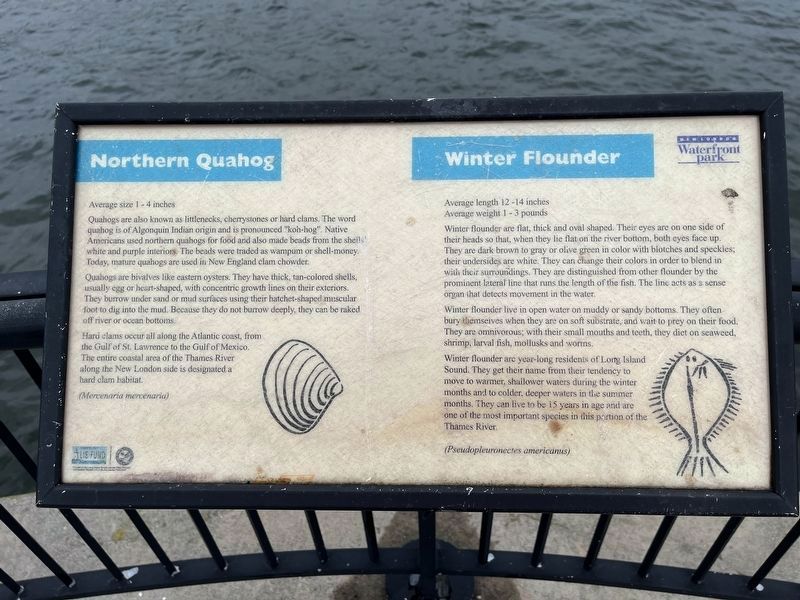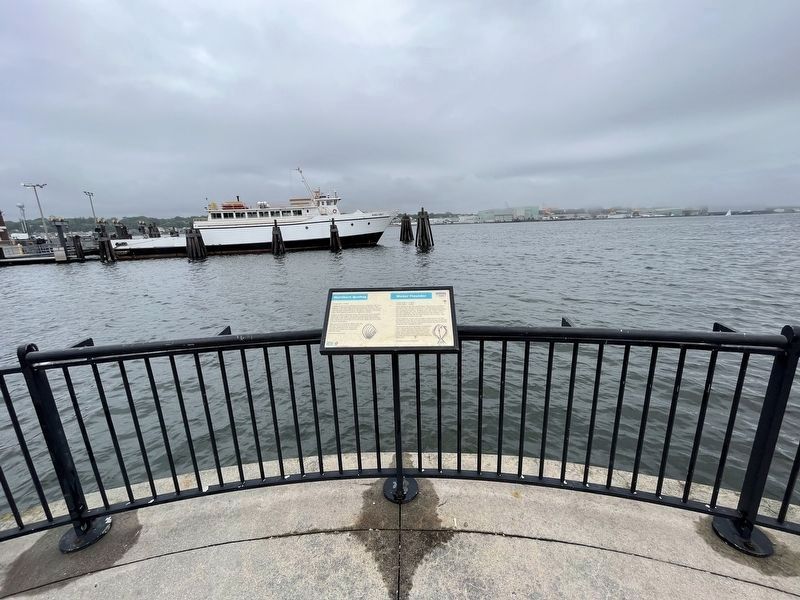New London in New London County, Connecticut — The American Northeast (New England)
Northern Quahog / Winter Flounder
New London Waterfront Park
Northern Quahog
Average size 1 - 4 inches
Quahogs are also known as littlenecks, cherrystones or hard clams. The word quahog is of Algonquian Indian origin and is pronounced "koh-hog". Native Americans used northern quahogs for food and also made beads from the shells' white and purple interiors. The beads were traded as wampum or shell-money. Today, mature quahogs are used in New England clam chowder.
Quahogs are bivalves like eastern oysters. They have thick, tan-colored shells, usually egg or heart-shaped, with concentric growth lines on their exteriors. They burrow under sand or mud surfaces using their hatchet-shaped muscular foot to dig into the mud. Because they do not burrow deeply, they can be raked off river or ocean bottoms.
Hard clams occur all along the Atlantic coast, from the Gulf of St. Lawrence to the Gulf of Mexico. The entire coastal area of the Thames River along the New London side is designated a hard clam habitat.
(Mercenaria mercenaria)
Winter Flounder
Average length 12 - 14 inches
Average weight 1 -3 pounds
Winter flounder are flat, thick and oval shaped. Their eyes are on one side of their heads so that, when they lie flat on the river bottom, both eyes face up. They are dark brown to gray or olive green in color with blotches and speckles; their undersides are white. They can change their colors in order to blend in with their surroundings. They are distinguished from other flounder by the prominent lateral line that runs the length of the fish. The line acts as a sense organ that detects movement in the water.
Winter flounder live in open water on muddy or sandy bottoms. They often bury themselves when they are on soft substrate, and wait to prey on their food. They are omnivorous; with their small mouths and teeth, they diet on seaweed, shrimp, larval fish, mollusks and worms.
Winter flounder are year-long residents of Long Island Sound. They get their name from their tendency to move to warmer, shallower waters during the winter months and to colder, deeper waters during the summer months. They can live to be 15 years in age and are one of the most important species in this portion of the Thames River.
(Pseudopleuronectes armericanus)
Erected by Long Island Sound Licence Plate Program; Connecticut Department of Environmental Protection.
Topics. This historical marker is listed in these topic lists: Animals • Anthropology & Archaeology • Industry & Commerce • Native Americans • Waterways & Vessels.
Location.
Other nearby markers. At least 8 other markers are within walking distance of this marker. Eastern Oyster / Summer Flounder (a few steps from this marker); Humpback Whale (a few steps from this marker); New London and the Sea (within shouting distance of this marker); New London Waterfront (within shouting distance of this marker); Whaling Days (within shouting distance of this marker); The Amistad (within shouting distance of this marker); Middle Passage to New London (within shouting distance of this marker); The Hotel Bristol (about 400 feet away, measured in a direct line). Touch for a list and map of all markers in New London.
Additional commentary.
1. About the marker
While most signs interpreting nature do not serve as historical markers, this sign is included in the database because of the inclusion of precolumbian Native American history on the northern quahog section of the marker.
— Submitted June 30, 2023, by Devry Becker Jones of Washington, District of Columbia.
Credits. This page was last revised on March 8, 2024. It was originally submitted on June 30, 2023, by Devry Becker Jones of Washington, District of Columbia. This page has been viewed 49 times since then and 10 times this year. Photos: 1, 2. submitted on June 30, 2023, by Devry Becker Jones of Washington, District of Columbia.

